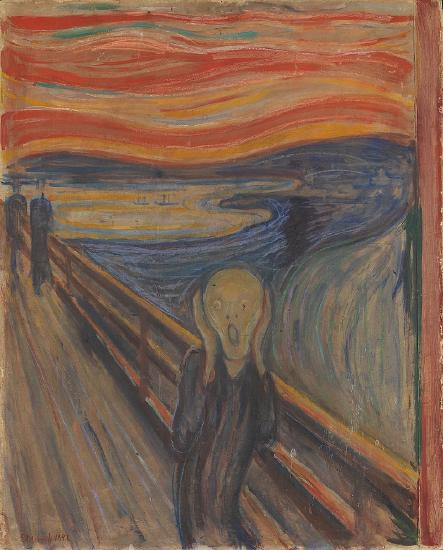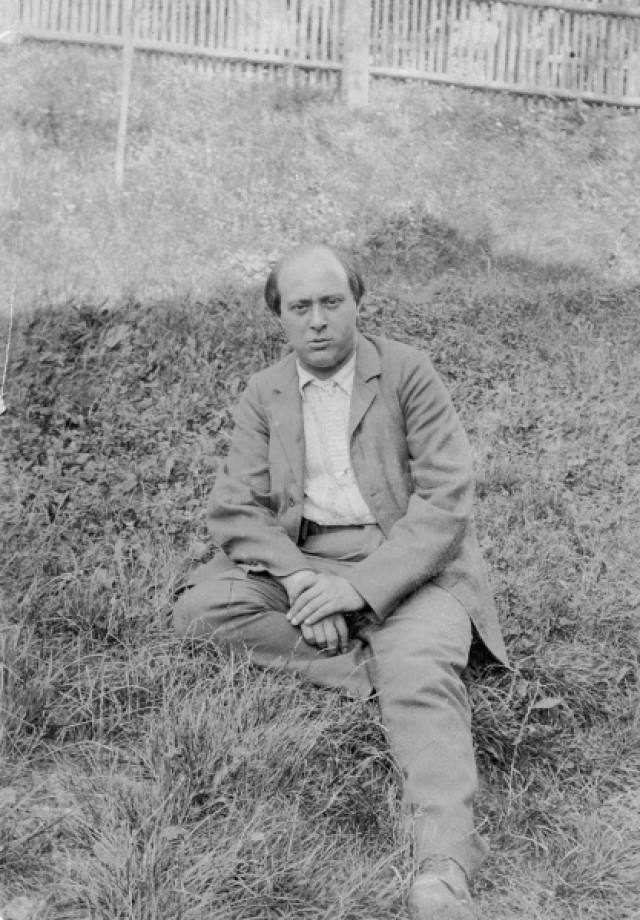6.4: Expressionism
- Page ID
- 168858
Expressionism.
 The Expressionist movement originated in the early 20th century in Germany. From the visual-arts perspective, Expressionism sought to express the inner-most thoughts and emotions; to represent the human psyche, which was quite dark, depressing, and full of anxiety in early 20th century Germany. The artistic movement thus reflected much of the socio-economic-political atmosphere that the people experienced. Two paintings help demonstrate this artistic movement: Edvard Munch's The Scream (1893) to the right, and Otto Dix's The Nun (1916). You can see how both paintings distort reality, though in different ways from the Impressionist era. These types of distortions create anxiety, and possibly fear in the viewer; the subject matter of the paintings are often dark, confusing, or both. With The Scream, we see a person-like creature without any defining features in the center, with almost child-like attention to details (note the two dots for the nose, and the pear-shaped head). This character is being pursued by two shadowy figures in the background. The distortions make it seem almost nightmare-like. View the short website regarding The Nun and you'll see even more distortions in a painting of a nun, the Virgin Mary, and the crucifixion of Jesus Christ in the upper-left hand corner: most paintings in preceding centuries depicting the crucifixion and the Virgin Mary would at least seem realistic --- by distorting reality, using unconventional coloring, and further distortions with lines and proportionality, we see a truly Expressionistic technique depicting an otherwise Holy image.
The Expressionist movement originated in the early 20th century in Germany. From the visual-arts perspective, Expressionism sought to express the inner-most thoughts and emotions; to represent the human psyche, which was quite dark, depressing, and full of anxiety in early 20th century Germany. The artistic movement thus reflected much of the socio-economic-political atmosphere that the people experienced. Two paintings help demonstrate this artistic movement: Edvard Munch's The Scream (1893) to the right, and Otto Dix's The Nun (1916). You can see how both paintings distort reality, though in different ways from the Impressionist era. These types of distortions create anxiety, and possibly fear in the viewer; the subject matter of the paintings are often dark, confusing, or both. With The Scream, we see a person-like creature without any defining features in the center, with almost child-like attention to details (note the two dots for the nose, and the pear-shaped head). This character is being pursued by two shadowy figures in the background. The distortions make it seem almost nightmare-like. View the short website regarding The Nun and you'll see even more distortions in a painting of a nun, the Virgin Mary, and the crucifixion of Jesus Christ in the upper-left hand corner: most paintings in preceding centuries depicting the crucifixion and the Virgin Mary would at least seem realistic --- by distorting reality, using unconventional coloring, and further distortions with lines and proportionality, we see a truly Expressionistic technique depicting an otherwise Holy image.
Edvard Munch's "The Scream" (1893). US-Public Domain.
Expressionism in Music.
 Like many of the artistic movements, Expressionism trailed behind the artistic medium by a few decades. German-born composer Arnold Schoenberg was known for embracing the musical aesthetic by incorporating new types of compositional techniques in his music. He is known as the "father of musical Expressionism" along with his two students Anton Webern and Alban Berg. He fled Germany prior to World War II in order to escape Nazism, and immigrated to America, where he lived the rest of his life in LA, California. He was known as a composer, an educator (he was a Professor of Music Theory at UCLA), and his essays on music and musical thought. He developed a completely new way of organizing sound, which is known in music circles as the 12-tone system. It's incredibly complex and difficult to explain in a Music Appreciation text, but the best way to explain it is that it completely embraces atonality.
Like many of the artistic movements, Expressionism trailed behind the artistic medium by a few decades. German-born composer Arnold Schoenberg was known for embracing the musical aesthetic by incorporating new types of compositional techniques in his music. He is known as the "father of musical Expressionism" along with his two students Anton Webern and Alban Berg. He fled Germany prior to World War II in order to escape Nazism, and immigrated to America, where he lived the rest of his life in LA, California. He was known as a composer, an educator (he was a Professor of Music Theory at UCLA), and his essays on music and musical thought. He developed a completely new way of organizing sound, which is known in music circles as the 12-tone system. It's incredibly complex and difficult to explain in a Music Appreciation text, but the best way to explain it is that it completely embraces atonality.
The word atonality refers to music that has no tonal center. Sing "Mary had a Little Lamb" to yourself and stop on the 2nd to last note ("her fleece was bright as -----"). The fact that your mind is demanding that you sing the last note demonstrates tonality -- in other words, there is a "home pitch" established by rules and principles of Western musical tradition.
Atonality, on the other hand, embraces pure dissonance. It lacks the sense of a "home note," and the music does not sound pleasant. Many music students can't stand the music because it lacks beauty in a conventional or traditional sense. You'll learn more and will hear what we're talking about in the Video Presentation on this unit.
Schoenberg also created his own unique way for singers to perform his music, called Sprechstimme, which translates to "speech-voice" or "speech-sing." It's an interesting combination of talking and singing that sounds incredibly haunting and eerie. The performer essentially speaks, but sustains the vowels to make a hybrid of singing with her speech. You'll hear this technique in the video presentation.
One of Schoenberg's most famous works is titled Pierrot Lunaire, which is a set of 21 poems of the same name by Albert Giraud set to music. Schoenberg wrote this collection for a small ensemble that consisted of a singer, flute, piano, violin, and cello. The combination of instruments became so popular that composers continue to write for Pierrot ensemble to this day. You'll learn more about this ensemble and this piece in the Video Presentation.
Arnold Schoenberg, published in 1903. PD-US.

